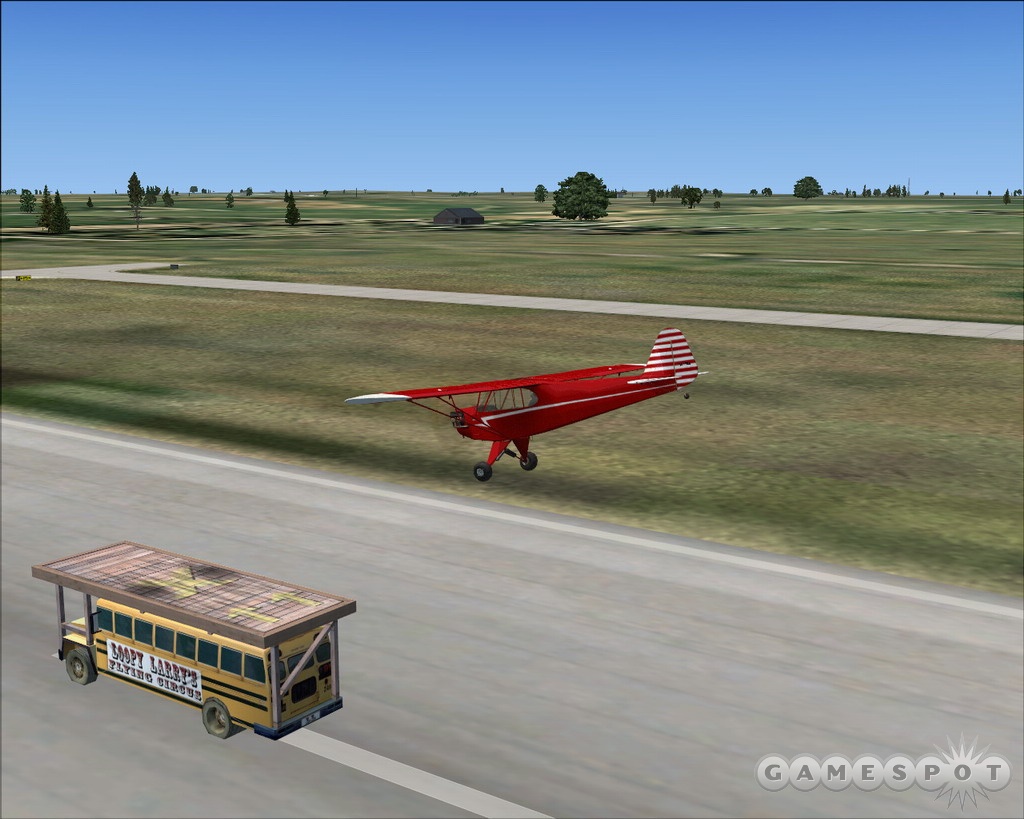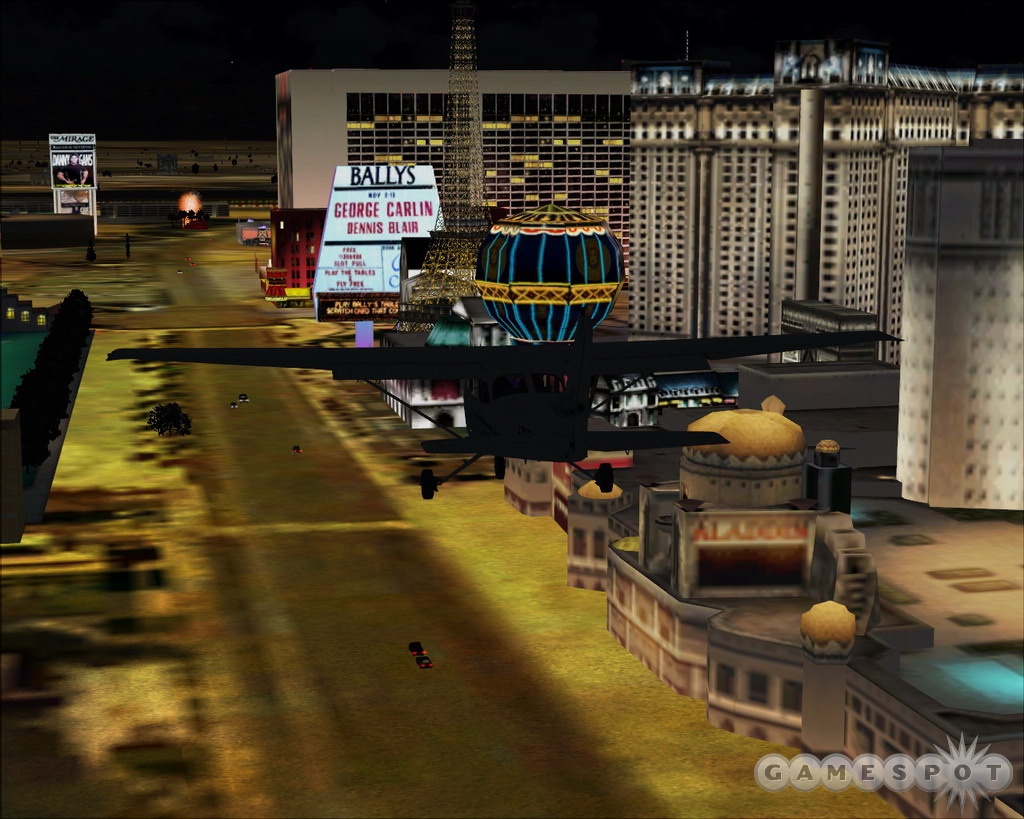Microsoft Flight Simulator X is an incredible piece of software, providing almost unbelievable capabilities for a consumer product. Unfortunately, on most systems at anything other than the lowest of the game's graphics settings, the simulation has significant performance issues. How much these issues hinder your enjoyment of the game will depend upon what kind of frame rates you need to enjoy a civilian flight sim.
All of the features hardcore simmers have come to expect in the Microsoft Flight Simulator franchise are here in spades, such as the entire world being modeled in exquisite detail; simulations of everything from ultralights to gliders to Cessnas to commercial airliners to helicopters; realism that makes the sim a great trainer for those seeking a real pilot's license; and more. But Flight Simulator X also adds significant features tailored to the player who would be bored to tears by simply flying from Akron to San Francisco in real time, most notably a series of goal-oriented missions (and an editor that will surely result in a huge number of add-on scenarios). These include well-done tutorials and many missions with compelling goals and surprising midflight twists. Some are lighthearted fun, such as playing the role of a stunt pilot (complete with announcer) trying to land on a moving bus or racing a jet-powered truck. Others are intense--for example, trying to fly a chopper to an exploding ocean oil rig and rescue stranded workers. Even simple missions have a compelling nature to them, particularly search and rescue scenarios where you may be seeking a capsized sail boat or a lost camper in snowy mountains. You collect rewards and souvenirs, which is a nice touch that adds an extra incentive to complete the tasks. Even hardcore simmers will find themselves sucked into these missions, wanting to find out just what's behind that clandestine mission flying into Area 51 or what is going to happen on your flight to pick up a famous movie star.
There are about 50 missions in the deluxe version of FSX and about 30 in the standard version. The deluxe version comes with 24 airplanes, versus 18 in the Standard version; more high-detail airports, 45 versus 40; more high-detail cities, 38 versus 28; the advanced Garmin G1000 glass cockpit; and the new tower controller module. This last feature lets you step into the control tower and take the role of the air traffic controller in multiplayer mode. While it probably won't keep you out of the cockpit for long, it is an interesting (and stressful) option. And for the record, if you're interested enough to purchase Flight Simulator X, you should go ahead and purchase the Deluxe version. All of the additional content makes it worth the added costs.
In addition to the missions, free flight mode provides practically unlimited options. You can select from any of the included aircraft (or add-ons that you may download or purchase) and fly to or from any of 24,000 airports around the world. Not only is it pretty much guaranteed that any significant airport that you'd like to fly in or out of is in the sim, but the odds are also good that your local neighborhood grass airstrip is in there, too. The new high-detail airports show off Microsoft's new "living world" emphasis in FSX. Now when you taxi into one of these featured airports, you'll see fuel trucks realistically dashing from gate to gate, luggage carts driving out to aircraft, Jetways extending to connect with your parked airliner, and more. The new active world extends beyond the airports, as you now can look down while in flight and see moving automobiles and trucks on the roads below. You'll also see a variety of boat and ship traffic while flying over water (buzzing a cruise ship with your 747 provides a special thrill!) and an assortment of wildlife, depending upon your location. While it sounds like a small touch, it does make a significant impact on the feeling that you're flying in a real-world environment.

The terrain graphics are significantly improved over Flight Simulator 2004. Higher-resolution textures are especially noticeable in areas such as harbors and coastlines, where the interface between the water and land is much more realistic. The autogen module, which creates terrain in areas that are not explicitly modeled, does a good job of generating ground features and vegetation that are appropriate for both the part of the world being generated and the weather for that location at that time of year. It's very nice to see how the world beneath you changes as you fly, for example, in December from Key West to Chicago. The development team has gone to extremes to make the world in which you fly as realistic as possible, even going so far as to map the stars in their accurate positions for your location and time of year. While it is unreasonable to expect that every feature and building in the entire world will be represented, most major landmarks and even many minor ones are present just about anywhere on the planet that you choose to fly. Weather, a significant factor in any pilot's life, can be set by the user; thus, if you want to test your skills in building storms or just want to see what it's like trying to bring in a 747 in the middle of the night in blinding snow, you can easily set that up. Or you can have the program download the current real weather for the location in which you are flying, with regular real-time updates. For those who are serious about testing their flight skills under precise conditions, you can even go in and set the cloud types, tops and bottoms, coverage, turbulence, icing conditions, precipitation type, density, altitude, wind conditions, and much more. The weather module alone is more sophisticated than you'd ever expect in a commercial, mass market piece of software.
Such attention to detail is why serious aviation buffs and anyone who simply wants to see what it's like to fly are so drawn to the Microsoft Flight Simulator series. If you just want to hop into a Learjet and fly from your local airport to Vegas, you can do that without worrying about 90 percent of the details. You don't have to actually taxi to any particular runway; you can simply push the throttle forward and take off, then keep an eye on various map options to navigate to your desired destination. But if you want to experience what a real-world pilot does on such a flight, you can develop and file a complete flight plan, go through a preflight check for your particular aircraft, check the weather for the flight path you'll be taking, follow ATC's instructions and taxi to the required runway, and hold until released to take off. Once in the air, you can follow the air traffic controller's instructions all the way to your destination, being handed off from one controller to the next as you progress. You can control all of the navigation equipment in your plane, fly with visual flight rules or instrument flight rules, and manage every detail of the plane's operation via switches and knobs in the cockpit, whether you're in a small Cessna or a huge jumbo jet. There are even options to set up planned or random equipment failures.

The aircraft in Flight Simulator X are all well done in terms of external and internal graphics. A major upgrade from Flight Simulator 2004 is the virtual cockpit renditions. These are now good enough that you'll spend the majority of your flying time in virtual cockpit mode. Most major controls in the cockpit can be directly clicked on and used, although you can also use keyboard commands if you prefer. Another welcome addition is the inclusion of the sophisticated Garmin G1000 cockpit in some planes (only in the deluxe edition), which is an integrated electronics panel that replaces most of the conventional controls in standard cockpits.
Microsoft has significantly enhanced the multiplayer options via its "shared skies" concept. Multiplayer has long been a major component of Microsoft's Flight Simulator world, particularly among the hardcore fans--for example, those enthusiasts who would pilot a jumbo jet on an 18-hour flight in real time as a member of a highly organized virtual airline. But as part of its overall push to open Flight Simulator up to the more casual player, Microsoft has made multiplayer simpler to get into, going to a server-based system, adding integrated voice over IP, and incorporating a couple of new features. The first is the ability to have someone fly in the plane with you. This is a great feature for training: An experienced pilot can virtually sit next to you in the cockpit and talk you through, for example, landing in VFR conditions or using advanced navigational controls on a cross-country flight. The other is the previously mentioned ability to join a multiplayer session as the air traffic controller. In this role, you sit in the tower with a visual on the airport and a radar screen in front of you. As in real life, your job is instructing all of the air traffic around you, including takeoff and landing instructions. And as in real life, this is sure to be a high-stress role like at a busy airport.

The power of this software package is mind boggling. But that power comes at a price. On a system with an Athlon XP 3400+, 2GB RAM, and an Nvidia 7800 video card (certainly not cutting edge but also not unreasonable, particularly for the broader market to whom Microsoft is trying to reach out with Flight Simulator X), with performance options all set fairly low, frame rates averaged about 8 to 14 frames per second. This same system runs Flight Simulator 2004 at high settings with frame rates averaging 25-plus fps. In higher-density settings, such as flying over Las Vegas or some detailed airports, frame rates rarely climbed higher than 10fps. When flying fairly high or in low-density areas, rates would range in the high teens. There's a lot of discussion about the sim's performance in the flight sim discussion forums, yielding a variety of config-file tweaks to boost the performance, but be forewarned that it will take some serious high-end hardware to run Flight Simulator X at high frame rates.
Is the poor frame rate a killer issue? That's arguable and depends on how much you require in terms of smooth frame rates in a civilian flight sim. Some people may want to wait until tweaks have been established that boost the performance or until they invest in new hardware. Others may decide to put up with less-than-stellar performance to be able to enjoy the amazing content and plethora of rich experiences that Flight Simulator X offers. What is not arguable is that Flight Simulator X provides a quantity and quality of flight simulation capabilities that would be amazing in a product that costs twice the price.
